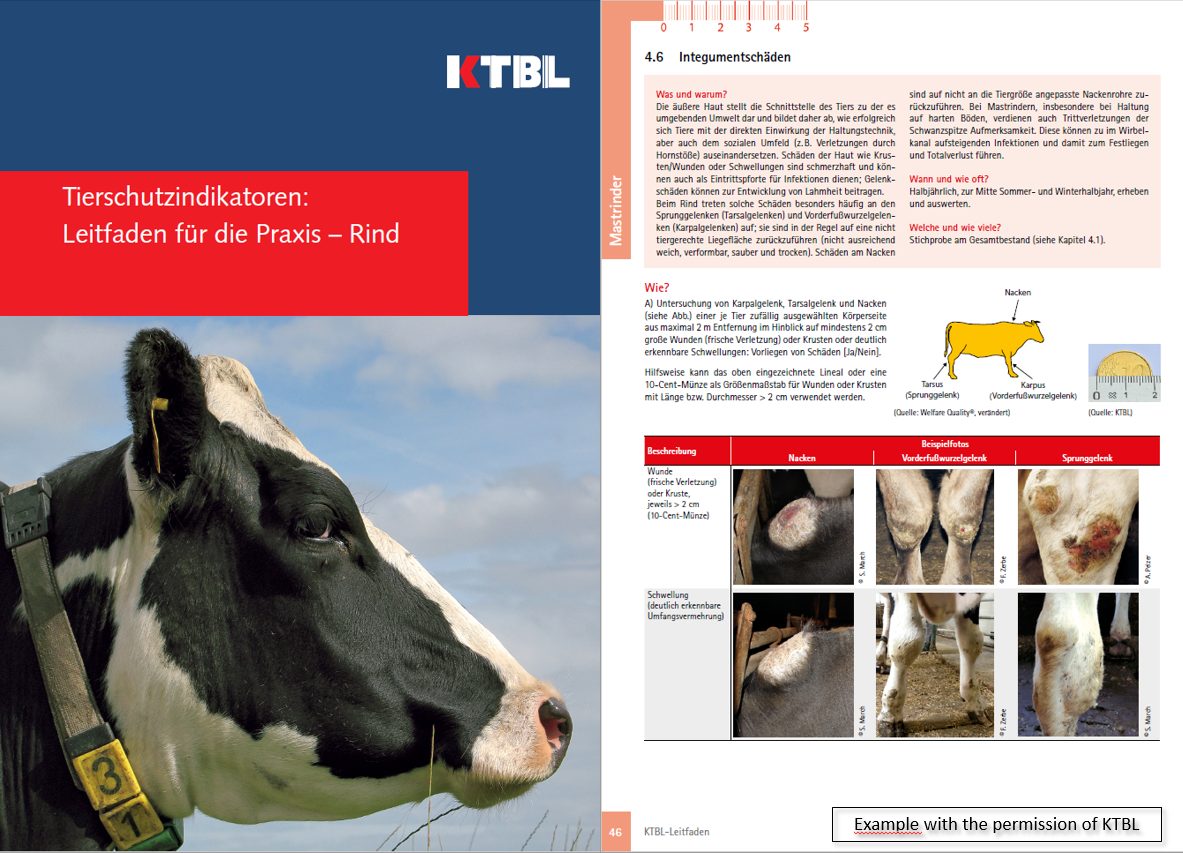Livestock farmers are highly responsible for the well-being of the animals they keep. They can be supported in this by carrying out a systematic weak point analysis. Furthermore on-farm self-assessment has been required by the German Animal Welfare Act (§ 11 Section 8) since 2014. The law requires the recording and evaluation of animal-based measures (termed “Animal Welfare Indicators” in the Act). However, the Animal Welfare Act does not contain any secondary legislation, so there is a lack of more precise provisions regarding details and scope of the self-assessment system. To fill this gap, the Curatorium for Technique and Construction in Agriculture (KTBL), the Thünen-Institut, the FLI and the University of Kassel developed a concept for on-farm self-assessment for cattle, pigs and poultry over several years. The guidelines for farmers “Animal Welfare Indicators – Cattle”, “ - Pigs” and “ - Poultry” are documents addressing livestock keepers including methodical instructions that are easy to understand for practical application. They are suitable for the use in the stable, having washable pages and robust ring binding and represent a practicable instruction manual for the farmers according to the present level of scientific knowledge. Thereby, the guidelines support livestock keepers to carry out self-responsible and systematic inspections of the welfare condition of their animals. These manuals include mainly animal-based indicators. Cattle farmers can use indicators for lameness, integument alterations or animal losses to assess the welfare situation in their stables. The KTBL has published specific guidelines for beef cattle, dairy cows and calves:
The project EiKoTiGer (Self-Assessment Animal Welfare; Eigenkontrolle Tiergerechtheit), supported by the Federal Ministry for Food and Agriculture in Germany, is testing clarity, practicability and reliability of these practical guidelines. Starting in spring 2017, the tools developed in the project were tested on more than 100 commercial farms.
Project EiKoTiGer Press release 2017 (Link)
Thünen Institute: EiKoTiGer links and downloads for fattening farms (Link)
New target and alarm values for the indicators just issued: KTBL-TI-Tierschutzindikatoren: Ziel- und Alarmwerte für Mastrinder (PDF, 2,6 MB)
In order to gain routine in using animal-based indicators training courses (such as online- and on-site training) have been developed and tested. Furthermore, data entry forms and an Excel-based calculator have been created in order to support the farmers. For further support an Android-based App is currently developed. An APP-prototype should be available by the end of 2020. For the evaluation of the indicators regarding acceptability of welfare levels, farmers have the possibility to compare their results with target values, which have been developed in the project.
It is recommended to conduct the self-assessment two times a year. Sample size depends on herd size and each assessment should take place as close to the animal as possible. Training and routine help to minimize the time needed.
This innovation helps identifying lameness problems in beef cattle. By analyzing the results, the aim should be to make the best decision for improvements, based on target and alarm values.
This method has a positive impact across:
- Socioeconomic Resilience – Risk management of beef cattle farms – The method offers tools for risk management related to lameness in fattening farms, for documentation and certification purposes and for analyzing economic results.
- Production Efficiency & Meat Quality – Animal monitoring tools in the fattening phase - This animal monitoring tool for assessing animal welfare on-farm helps to ensure production efficiency based on health indicators.
